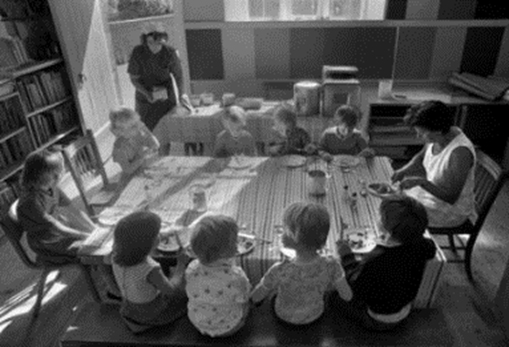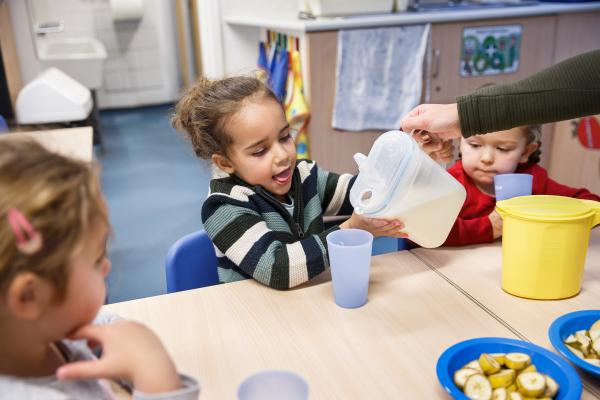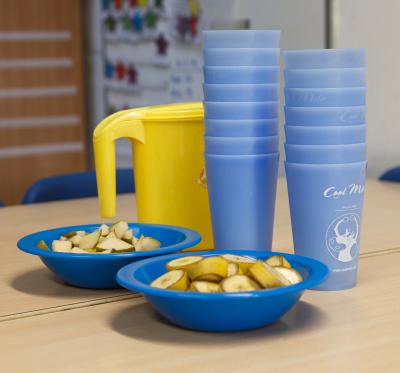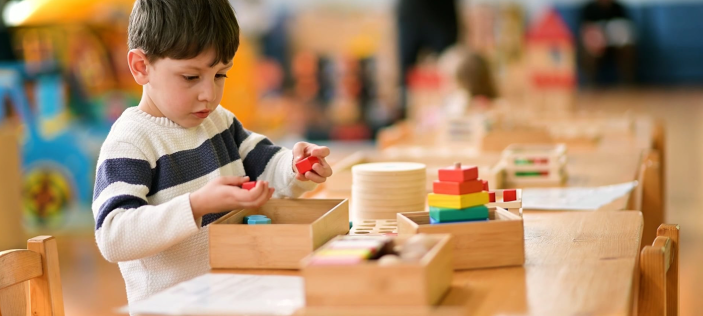So here I am dragging up my memories from my time in daycare in the 1970s and 80s! Back then some children who were early drop-offs had breakfast which was normally porridge or toast and marmite. Children would have a lunch at 11.30am and then tea at 4pm. We didn’t have any snack times in between or, I am a bit horrified to say, any access to water or drinks. If it was very hot outside we would bring out some drinks for the children, but I don’t remember having anything in the rooms.

In one of my nurseries, as my room was upstairs in a house, we had a lift from the kitchen and the cook would put our lunch in it down in the kitchen, but sometimes forget to press the button to send it up to us. We couldn’t ‘call’ it so would have to rattle the doors our end and shout down to Vera the cook and hope she heard us! As a staff team of two with a family group of 8 children from around a year old to 5 years, we would sit with the children and eat a lunch ourselves. The dishes would be on the table and we would serve each child. We would help the little ones and the olders would use knives and forks and be independent. We always had cloth tablecloths which were washed after every meal as we had a lovely laundry lady called Eve.
When we were putting children down for a sleep in the sleeping bags on the floor after lunch, Eve would pop her head round the door and ask if we wanted a cuppa. She would then bring it round for us while we sat on the floor stroking children’s eyebrows till they went to sleep. At tea time again we sat with the children and ate some tea. This was usually bread or crackers and sandwich fillings; marmite, sandwich spread, lemon curd, jam, and again when they were able to, the children would spread their own butter and choice of filling. It was always a very social time with lots of chat from us and the children.
So what has changed in the years following? Snack time has come in and we offer our children a snack mid-morning or in the afternoon. Another memory of mine from working in a nursery school in the mid-1990s was having sandwiches and milk cartoon on a rolling snack format. Children would come along when they were ready and help themselves. One child would be chosen towards the end of the allotted time to go round the nursery and the garden with a coloured disk calling out for any child who hadn’t has snack that it was closing soon. That eventually metamorphasised into a sit-down snack in our small groups and it was usually biscuits and milk cartoon or water to drink. Oh, the joy of a Maryland chocolate cookie or a pink wafer mid-morning!
In the 2000s that changed again with the emphasis on healthy eating to fruit or cheese and crackers. Children used to peel their own satsumas or a half banana, and enjoyed the fun of the adult using an apple corer and leaving the core with the stalk sticking up in the corner and we all used to sing happy Thursday (or whatever day it was!) to us and pretend to blow out the stalk candle! I remember trying to encourage a reluctant fruit eater by saying it was an ice cream apple or satsuma piece and getting the child to just lick it as a first step. This eventually worked and the child began to actually eat pieces of fruit. Mum was so pleased!
These snack times were very social and I used to talk to the children about all sorts of things, my cat, what I needed to buy in Tesco’s, what I was doing later. It’s so important to see snack and meals as a time for conversation, really low key chit-chat as that is how children learn firstly language, but then how to wait, to take turns in the conversation, feel valued for something they have said, and to learn to have a conversation with another child.
Another element of our snack times were Makaton signs. We used them all the time for all the children so that if a child came into our group that had limited language skills for any reason, there was a way to communicate and no child felt singled out as we were all doing signs. This supported all our children with SEND and especially a child with very little English who had just come over to this country and was very difficult to settle. I remember the first time she signed for biscuit, I wanted to shout from the rooftops but played it very cool and calm so as not to overwhelm her and offered her the biscuit box. The smile and relief on her face that someone had understood her was amazing.
So since I have been an EYC and visiting lots of different preschools, nurseries and schools over the last 13 years I have seen snack time change again from a formal sit down together snack sometimes as whole groups which can look a bit like an Oliver Twist scenario with long lines of tables and children, small group adult led snack, or rolling snack stations with children helping themselves.

There are advantages and disadvantages with either a sit down or a rolling snack. One promotes independence and doesn’t interrupt children’s play, the other promotes a social occasion with an adult supporting and lots of language. There really isn’t any right or wrong, Ofsted don’t mind which scenario you use as long as it is meeting the needs of your children. Of course this will change with each new cohort coming through. What worked last term/year, may not work now and you will have to change.
Thinking about meal times (lunch or cooked nursery tea) these are usually always sitting down with a member of staff. You may have meals brought to you already served on plates or have a trolley where you serve from a dish. Again it’s important for children to learn how to be independent, serve themselves and use a knife and fork when they are ready.

One thing we all learned for the Cultural Capital All About Me workshop recently is that we must know the child’s ‘frame of reference’ when they arrive with us. What are mealtimes like for them at home? Are they grazers who wander about with food, do the family all sit with plates or trays on the knees and watch TV while eating, or are they a ‘sit at the table’ family? No one is judging here, we just need to know so we know what the child experiences are and we can expand on that frame of reference so they understand how other people eat their meals and what is expected at preschool or nursery or in the wider world. It might be that you are teaching children how to eat when in a shared space. This may take a while but clear rules and boundaries must be communicated and expectations followed through.
Of course we need to talk about allergies, medical, cultural, and dietary needs here too. How do you ensure that these are followed and that every person including cover/bank staff are fully aware of each child’s needs? I have seen different colour place mats to indicate which children need particular foods which seems to work well. You may have your own methods, just make sure everyone knows what they are.
Lastly, or should really have been firstly, we think about nutrition. I have listed below some websites with menus and guidance on the balance of vitamins minerals protein etc that children need and an article which give interesting historical insights into how children have been fed over the years, and how successive governments and acts of parliament have changed what has been offered to children in schools and settings.
As part of my NNEB training back in the 1970s we learned how to cook for children and also what the correct balance of nutrients are. It seems that this isn’t covered these days in early years courses, it certainly wasn’t when I taught level 1 and level 3 courses in the mid-noughties. If we understand the correct balance between proteins, fats, carbohydrates etc., it makes it easier to plan and provide a balanced diet. It is my personal opinion that we feed our children far too much on occasion. Plus many of us are not much good at portion sizes which is maybe why we have an obesity problem in the UK. Have a look at the Eat Better Start Better resources below to find out more about portion control for young children.
So let’s enjoy our snack and meal times with young children and see them for the important social occasions they are with a myriad of opportunity to ‘teach’ many different things while we enjoy something tasty.
Gillard D (2003) Food for Thought: child nutrition, the school dinner and the food industry
Government guidance on menus for EY



